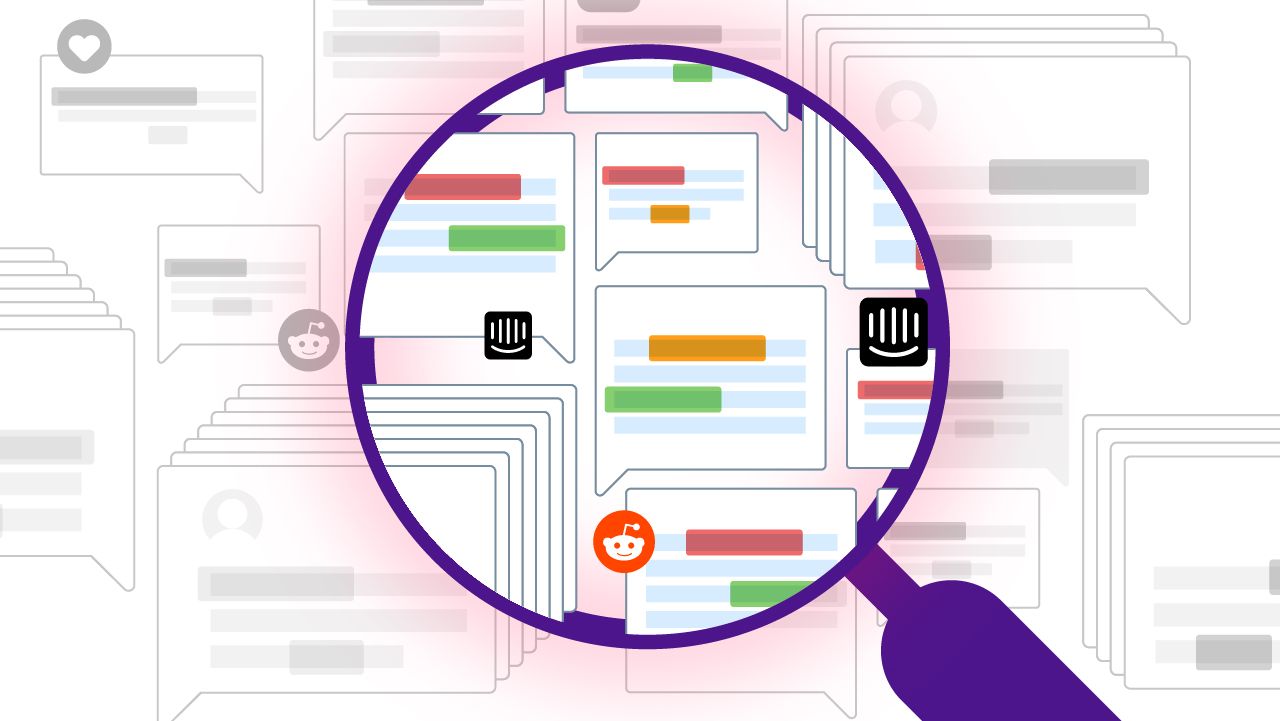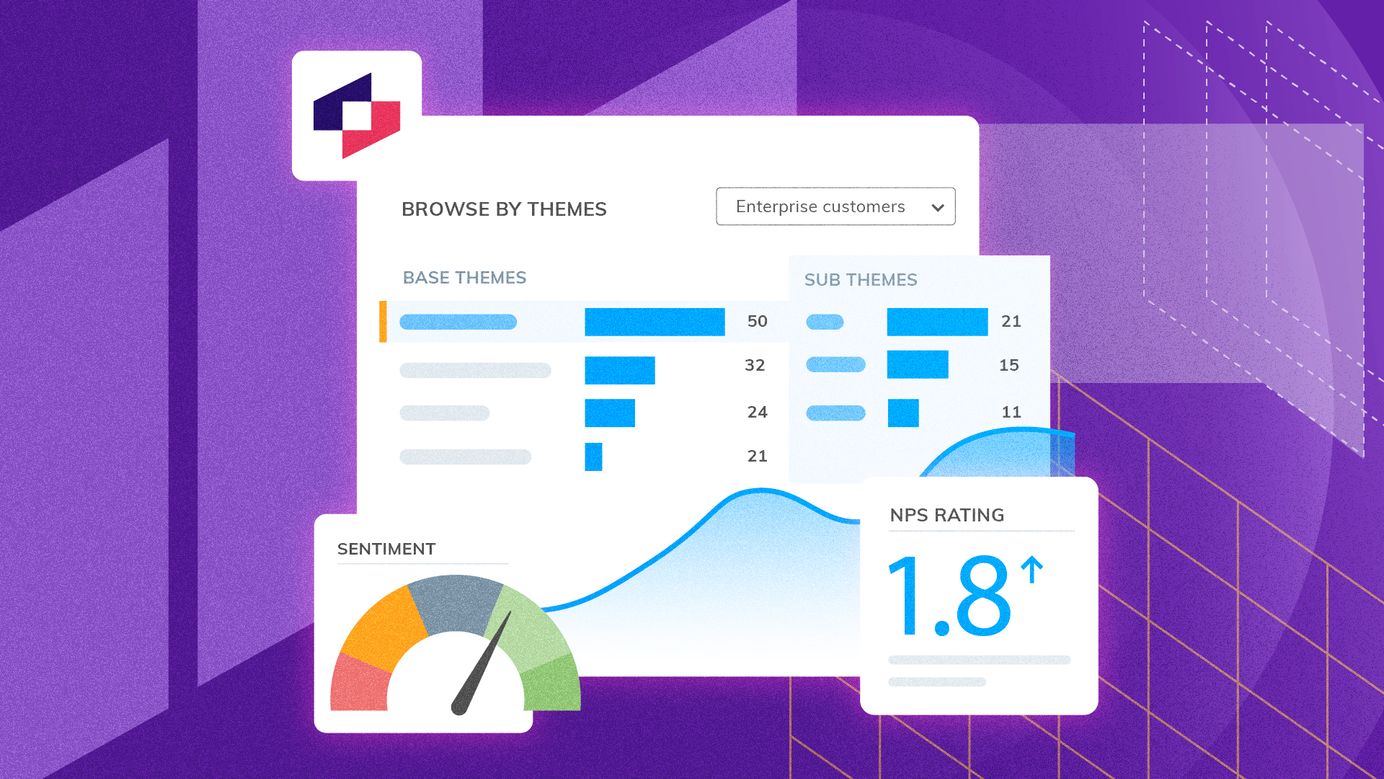
Customer Experience Analysis: How To Measure & Improve CX
What to consider when evaluating a customer experience analytics solution, and how to use customer insights.
Despite brands with superior customer experience reporting 5.7 times more revenue than their competitors, CX champions sometimes face an uphill battle. To unlock the true value of customer experience and voice of customer investments you need to be doing regular customer experience analysis.
Measuring and improving CX starts with gathering as much customer intel as possible. This guide covers the key components of customer experience analysis, including how to choose a customer experience analytics solution. We'll dig deep into how to use customer insights to build long-lasting, meaningful, and mutually beneficial customer relationships.
Understanding Customer Experience Analytics
What is Customer Experience Analysis?
Customer experience (CX) analytics involves collecting, processing, and analyzing customer data to measure and improve CX.
The overall goal of customer experience analytics is to get a better, deeper understanding of your customers – what they need, want, and value – and their experiences with your products and services. This information can be analyzed in many ways to help your business create great customer experiences. Marketing and customer-facing teams can use the insights gained to boost customer engagement, satisfaction, and loyalty. Product teams can resolve issues, improve products and services, and identify opportunities.

What Data Does Customer Analytics Use?
Customer experience analytics uses data from direct and indirect feedback sources.
Direct feedback sources refer to the data and information you’ve requested directly from your customers, including:
- Net Promoter Score (NPS)
- Customer Effort Score (CES)
- Customer Satisfaction (CSAT)
- Voice of Customer (VoC)
- Open-text feedback from customer surveys
- Customer responses on social media
Indirect feedback is the data you collect from the interactions you have with your customers, including:
- Average Handle Time (AHT)
- Customer lifetime value
- Average spend
- Customer churn rate
- Customer renewal rate
- Voice and chat metadata, transcripts, and analysis
- Social listening
- Customer review monitoring
Why Customer Experience Analytics Matters
Measuring customer experience analytics is important because it provides insight into the critical moments within the entire customer journey that, when improved or amplified, create a memorable customer experience. Not only do your customers benefit from a better, more personalized experience that meets or exceeds their expectations, but there are many business benefits, too.
Enhanced customer satisfaction
Customer experience analytics involves pulling and consolidating customer data from multiple sources, including direct and indirect feedback. By analyzing this data, you get a more well-rounded and detailed picture of what your customers want and need. You uncover what steps your business can take to improve their satisfaction levels. You can do this for specific business functions like product, customer service, sales and marketing, or your brand as a whole.
Personalized customer experiences
Understanding your customers better allows you to personalize their experience. This might mean more targeted marketing campaigns for certain customer segments. Or you might tailor certain products and services to specific types of customers. Once you know what your customers want and what they don’t want, you can create experiences that better match their expectations.
Boost customer loyalty and business growth
Creating and delivering more personalized customer experiences is about meeting their specific preferences. Doing this helps cultivate a deeper sense of belonging and appreciation – both of which are key drivers of customer loyalty.
And, when 83% of customers say they feel more loyal to brands that respond to feedback, and 68% of consumers are willing to pay more if a brand is well-known for its customer experiences, it becomes apparent just how much impact customer experience analytics can have on revenue growth and profitability.
Keeping a competitive advantage
Using customer data to improve CX is essential for standing out in today’s ultra-competitive business market. When customers feel like their voice is heard and you put the Voice of the Customer (VOC) at the center of your decision-making, you’ll build long-lasting relationships with your customers. This increases the likelihood of repeat purchases, a higher customer lifetime value, and more positive word-of-mouth.
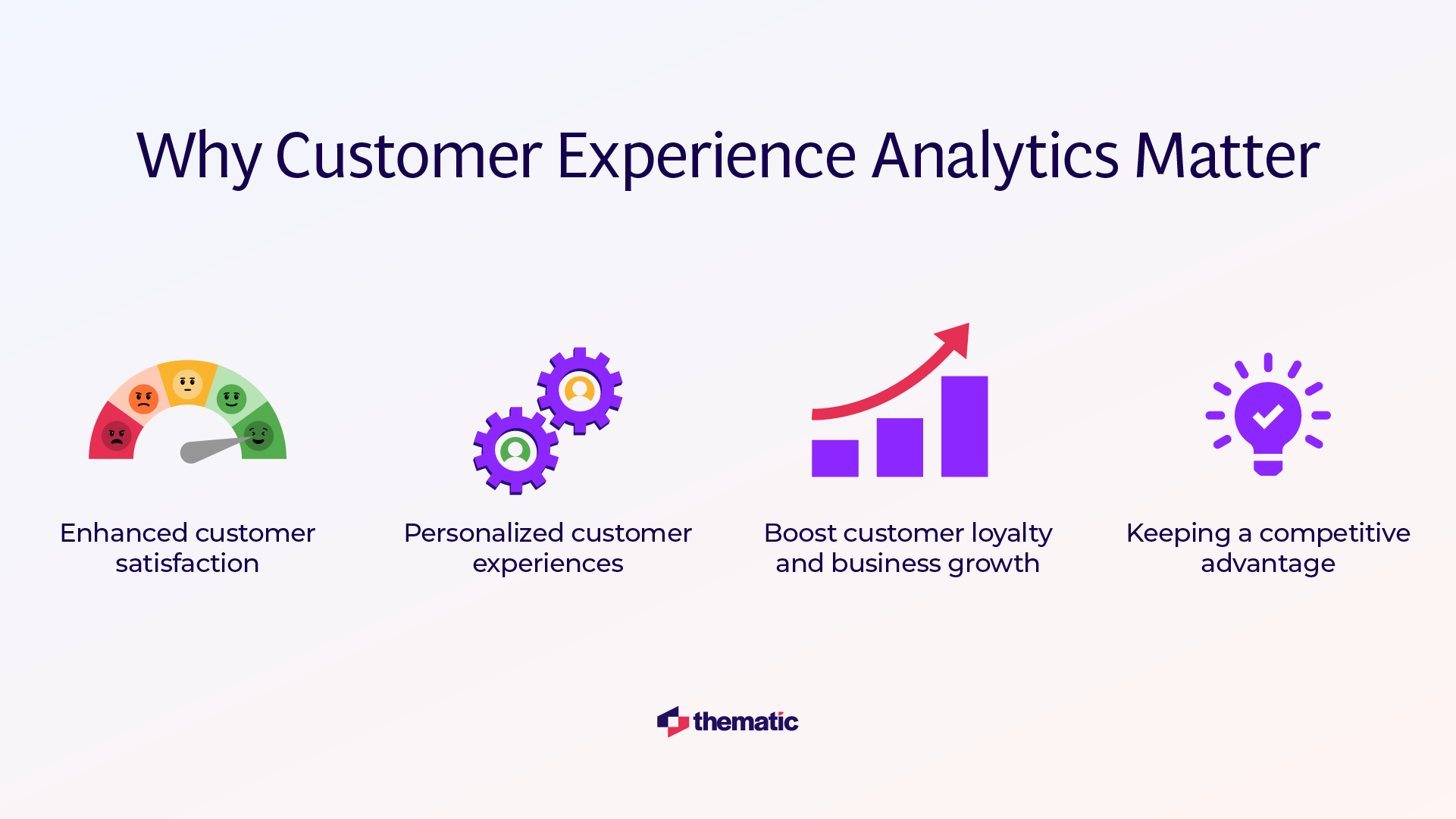
What You Need for Customer Experience Analysis
Before you get started with CX analysis it’s important to do the groundwork. Here’s what you’ll need to hit the ground running and get the best results from your analysis.
- Strategy and goals for your CX analytics program: Think about what you want to achieve with customer experience analytics. You might have particular questions you want to answer or maybe you want to identify the major issues your customers are facing on their journey.
- Stakeholder buy-in and cross-organizational support: It also pays to ask key stakeholders what they want to achieve. Sharing your plans across your organization helps secure support and collaboration. This is especially important when it comes to implementing changes after you’ve done all the analysis.
- Customer personas: Understanding who your customers are and what they want is useful. This data can be combined with your CX analysis to find out what certain types of customers want. For example, you might focus on your highest-value customers and gather deeper insights into their needs.
- Customer journey roadmap: As well as customer personas it’s good to map out the typical customer journey and identify any key touchpoints. This might include purchases, abandoning the cart, customer cancellations, new customer onboarding, and product returns. These are all points at which it would be really helpful to know what your customers are thinking!
- Customer data: Once you’ve thought through your goals and got to know your customers, you’ll be ready to choose which data to use. This might include surveys, customer support interactions, online reviews, and social media. We’ll cover this in more detail in the next section.
- CX and Analytics tools: Your insights are only as good as the tools you use. Advanced AI-powered analytics tools make it easier than ever to analyze thousands of pieces of customer feedback in seconds. Other types of tools enable you to send out customized surveys or manage the whole customer journey on one platform. Again, we’ll cover how to choose the right tool for your organization later in this article. Overall business goals: And finally, don’t forget to think about how CX analytics feeds into your overall business goals. For example, you might focus on ways to cut costs. This could include discovering and addressing customer issues to reduce the number of customer support requests.
The 4 Steps of Customer Experience Analytics
There are four key steps for carrying out customer experience analytics:
1. Collect Customer Feedback
2. Data Integration
3. Qualitative Analysis of Customer Experience Feedback
4. Share Insights and Implement Changes
Step 1: Collect Customer Feedback
There are a myriad of ways you can engage with your customers to find out what they think you’re doing right and wrong. The more feedback you collect, the clearer and more specific your insights will be when reviewing your customer experience analytics data.
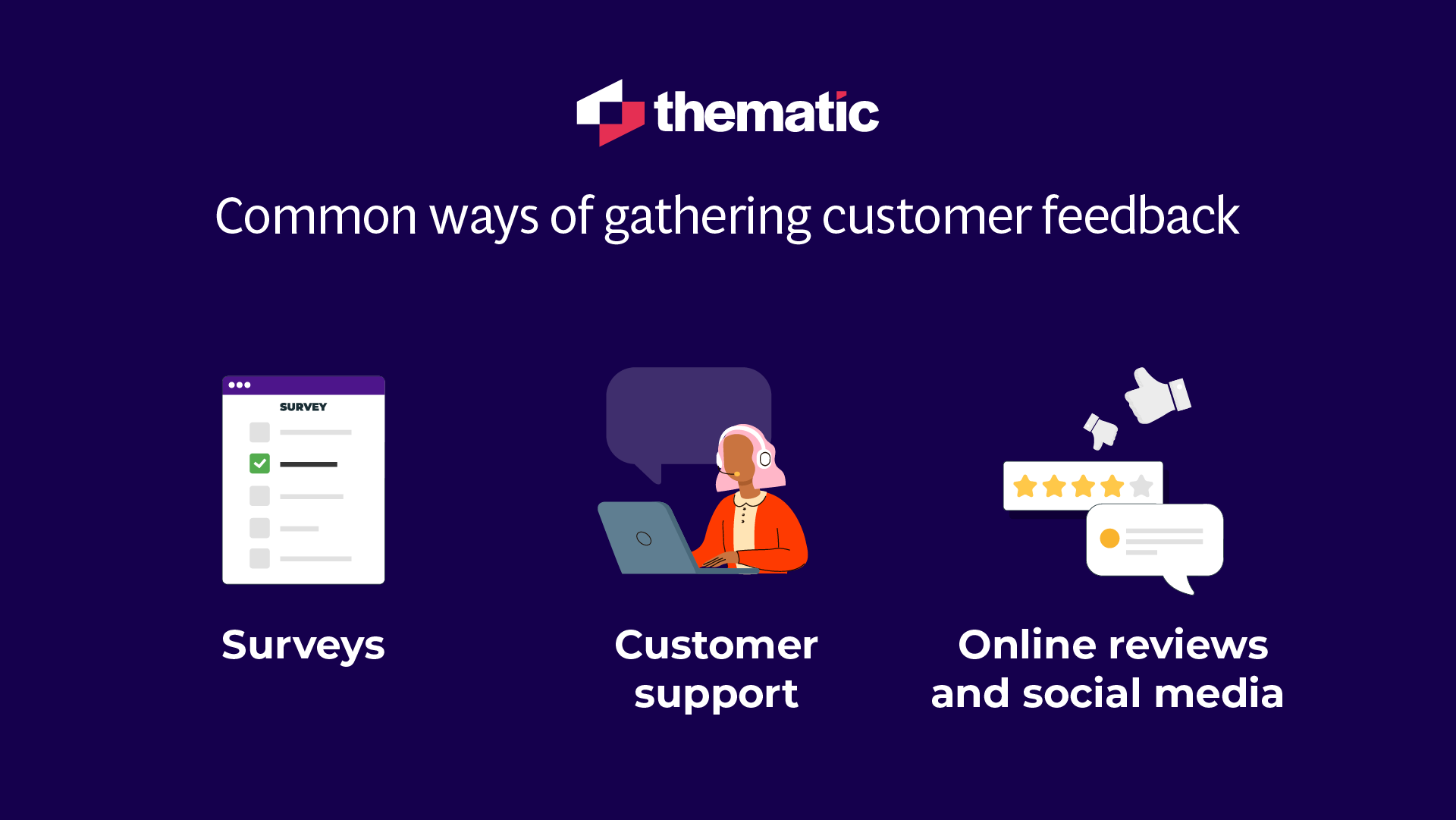
How to Gather Customer Feedback:
Surveys
People are much more likely to share their honest opinions when they can respond to prompts anonymously. Asking your customers to complete surveys like NPS, CSAT, or CES along various stages of the customer journey allows them to submit feedback regularly, which you can collect, analyze, and summarize using feedback analytics software.
Customer support
Customer support interactions like phone calls, support tickets, chats, and emails are another great source of feedback data. A big part of this is conversational analytics, which helps you dig into metrics like call response times, resolution times, and ticket volumes to uncover trends and issues.
Online reviews and social media
What people say through online reviews and on social media platforms can also tell you a lot about your business and the quality of your customer service. A feedback analytics tool will help you find common themes within that data, which you can use to build a strong VOC program.
Customer interviews and focus groups
To get to know the CX experience even better you might set up individual customer interviews or focus groups. In these settings you can ask more specific questions and get more detailed answers. You might discover pain points you never knew existed because customers didn’t have the time or motivation to share them on online surveys.
Mystery Shoppers
If you have physical stores or locations, you could hire mystery shoppers to visit and give feedback on the customer experience. This is a good way to get targeted feedback to supplement your other customer data.
Financial and Operations Data
Additional data from finance, operations, and other departments can add to the overall CX picture. For example, you could link customer comments on out-of-stock items to stock management data to find ways to improve stock levels. Or you might dig into website analytics to discover why customers abandon their cart at a certain point.
Step 2: Data Integration
There are a multitude of channels and sources where you can collect customer feedback. But collecting that data isn’t enough. It must be consolidated for analysis. And it's not just about having everything in one place. Although that does reduces manual intervention and improves data management. Integrating feedback data is essential for ensuring the highest quality CX insights based on a complete, accurate picture of your customer interactions.
Step 3: Qualitative Analysis of Customer Experience Feedback
As new technologies like Generative AI and machine learning continue to evolve, so does the impact of data and analytics on customer experience – and the number of companies utilizing advanced analytical techniques.
Sentiment analysis
Explicit feedback is great, but some of the most powerful insights come from what your customers say implicitly. Sentiment analysis uses natural language processing to assess the underlying emotions, feelings, and thoughts in the feedback you receive. This type of analysis is useful for identifying areas where there is growing negative sentiment. Then you can make proactive changes before minor issues become big problems.
Predictive analysis
This is the process of forecasting future behavior using data. It uses a mix of artificial intelligence (AI), machine learning, statistical models, and data analysis to find patterns and predict trends or behaviors based on historical data.
Applying predictive analysis to customer feedback can help you predict and proactively address customer issues and interactions. For example, you may want to know which customers are most likely to respond to a particular marketing campaign and improve your ROI – and that’s where predictive analytics can give you confidence in your decision-making.
Thematic analysis
As Alyona Medelyan, CEO and co-founder of AI analytics tool Thematic, writes, when it comes to customer feedback, three things matter:
- Accurate, specific, and actionable analysis
- The ability to see emerging themes fast
- Transparency around how results are determined
Thematic analysis ticks all of those boxes. It’s a qualitative data analysis method that identifies phrases or themes and organizes them into insights that are easy to validate and understand. When combined with sentiment analysis, it’s one of the most powerful ways to turn high volumes of unstructured feedback into actionable intelligence that improves CX, user experience, and profitability.
Below you can see how Thematic enables you to dig deep into a particular theme. In this case we’re exploring the theme “swiping feature”. Thematic’s analysis of the data shows that this theme is associated with negative sentiment in 88% of cases. It sounds like there are issues there worth fixing!
You can see specific sentences associated with that topic and get a deeper understanding of why your customers feel this way. For example, you can see negative customer comments like “it’s simply not functional” and “forces me to swipe away and back”. These can help you identify exactly what the issue is and address it.
Step 4: Share Insights and Implement Changes
The final step is arguably the most important. The main aim of CX analysis is to actually improve the customer experience.
The best way to do this is to share your insights across your organization. Include enough data as is appropriate so stakeholders can see why you are suggesting certain changes. It’s easier to get buy-in for data-driven decisions when teams understand the “why” behind them.
Actionable insights typically fall into two categories:
- Individual issues affecting certain customers that can be handled in isolation. This might include payment problems or one-off complaints about certain events or experiences. These can usually be handled on a one-to-one basis with the customer service team reaching out to the customer.
- Systemic issues that recur across many customers’ experiences and require a more comprehensive approach. These could be product faults, operations issues, or problems with your website. These issues need to be addressed at a department or company-wide level.
At this point it’s good to reflect on all the hard work you’ve done and what you’ve achieved so far. Share your successes across the organization, and with your customers too! This can help boost brand loyalty and customer retention when your customers see you are really listening to them.
Don’t forget that the work doesn’t end there. Monitor and track customer sentiment to see what impact your changes are having. And remember to keep checking for new issues that might come up. CX analysis is an ongoing process.
Key Metrics for Customer Experience Analytics
For long-term success you need a way to measure the CX and customer satisfaction. Here are some metrics you can use to track the progress of the changes you are implementing.
Customer Satisfaction Score (CSAT)
Customer Satisfaction Score (CSAT) is a pivotal metric in customer experience analytics that indicates customers' overall satisfaction. Typically, CSAT is measured by asking customers to rate their satisfaction on a scale, with higher scores indicating greater satisfaction. This metric is invaluable for businesses, offering direct insights into customer behavior and what you can do to increase customer satisfaction.
Net Promoter Score (NPS)
Net Promoter Score (NPS) is a score created by Bain & Company that evaluates customer loyalty and brand appreciation. It involves asking asking how likely people are to recommend your business to others on a scale from 0 to 10. NPS helps gauge overall customer satisfaction, identify areas for improvement, and track customer sentiment changes over time.
Customer Effort Score (CES)
Customer Effort Score (CES) assesses how easy it is for customers to interact with your company or resolve issues. It's used in customer experience analytics to pinpoint friction points across the entire customer journey, helping businesses streamline processes and enhance overall satisfaction.
Customer Retention Rate
Customer retention rate measures the percentage of customers a company retains over a specific period. In customer experience analytics, this metric is used to evaluate the success of initiatives aimed at improving satisfaction and reducing churn.
Customer Churn Rate
Customer churn rate indicates the percentage of customers who stop engaging or doing business with you during a specific timeframe, serving as a key indicator of customer dissatisfaction or competitive pressures.
Customer Lifetime Value (CLV)
Customer Lifetime Value (CLV) represents the total revenue a business can expect from a single customer over the entire duration of their relationship. In customer experience analysis, CLV helps companies understand the long-term value of customer relationships, guiding marketing efforts, retention strategies, and resource allocation to maximize profitability.
Customer Experience Analytics Tools & Software
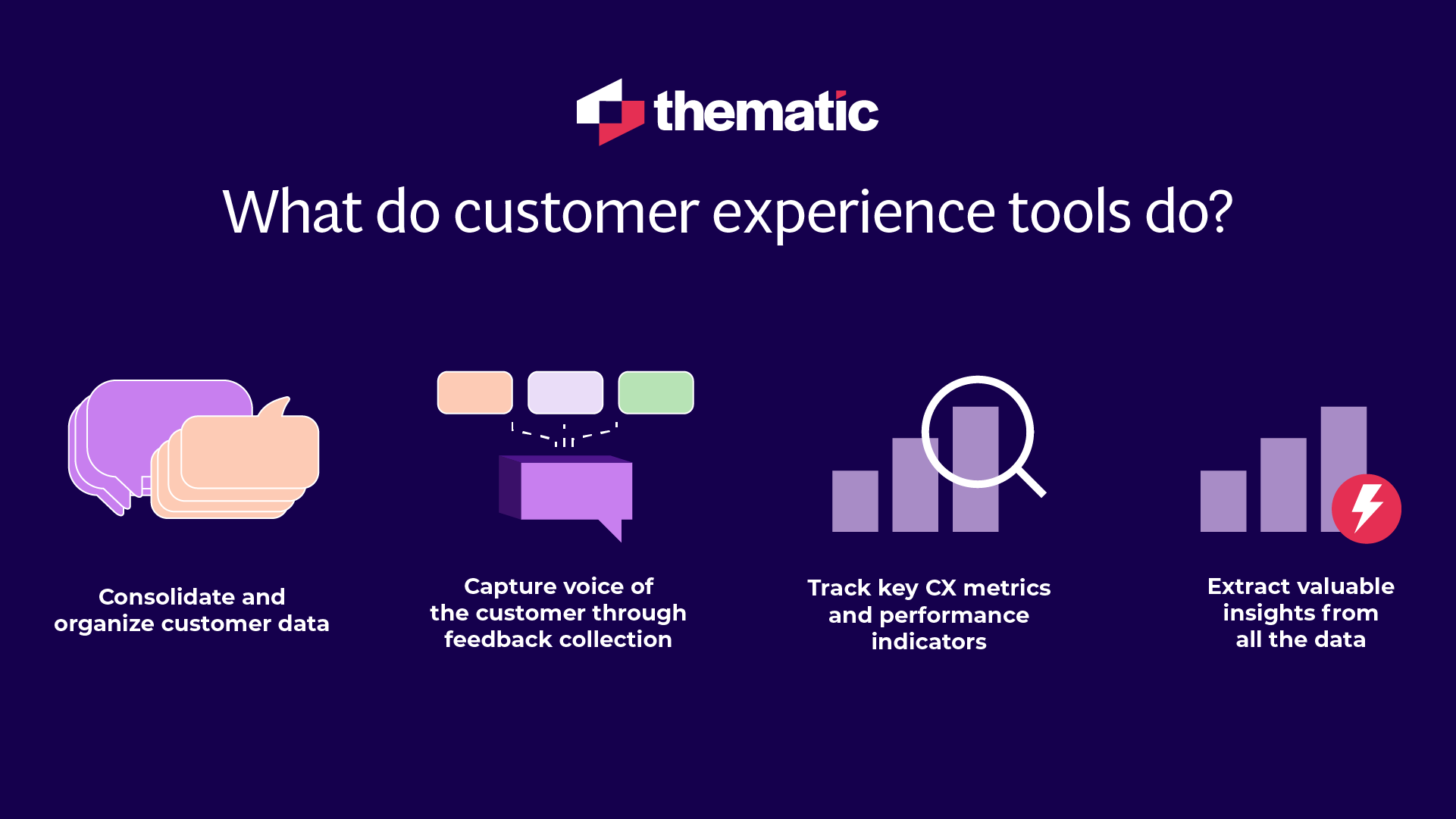
What do customer experience tools do?
Customer experience analytics solutions enable businesses to interact with their customers at various stages along the customer journey. Some tools focus solely on surveys and feedback collection, while others offer broader analytics features. However, they all aim to enhance your customer experience by doing the following:
- Consolidate and organize customer data
- Capture the Voice of the Customer through feedback collection
- Track key CX metrics and performance indicators
- Extract valuable insights from all the data you have on your customers
Choosing the right CX tool for your business
Every business is different, so when adding any software to your tech stack, it’s important to follow these best practices:
Set clear objectives
The first step is defining what you want to achieve with your customer experience analytics.
- Do you want to focus on product development and improvement?
- Are you working on establishing a voice of the customer program?
- Is digging into your contact center data and its goldmine of insights top priority?
The answers to these questions will help narrow down the tools best fit for your business. You’ll also want to consider the size of your CX team and their experience using customer experience analytics tools.
Prioritize data quality
The accuracy of your customer experience analytics will largely depend on the quality of your customer data. That’s why it's critical that once you have your data sources, you put strategies in place to maintain clean, validated data. This means removing errors, duplicates, missing values or irrelevant data that will skew your results. You must also update and refresh your data regularly to keep it current and accurate. With the right CX analytics tool, you can automate some or all of these tasks.
Regularly monitor reporting
One of the most important foundations of customer experience analytics is establishing a system for continuously tracking and analyzing key metrics.
Key customer experience metrics are vital signs of customer satisfaction, engagement, and behavior. Customer experience analytics software automates tracking these metrics and produces AI-generated reports detailing recurring issues and trends in customer interactions.
You’ll be able to use this information to proactively address the root causes of dissatisfaction or disengagement quickly while empowering your organization to improve the overall customer experience. Once you’ve made changes, assess their effectiveness and refine them based on ongoing monitoring and reporting to further improve and optimize the customer experience.
Popular CX Analytics Tools & Software
For many organizations, the challenge isn’t so much about collecting customer feedback. It’s transforming CX data into actionable insights. CX and user experience teams are often overwhelmed with data and don’t know how to understand it, use it, or report on it effectively.
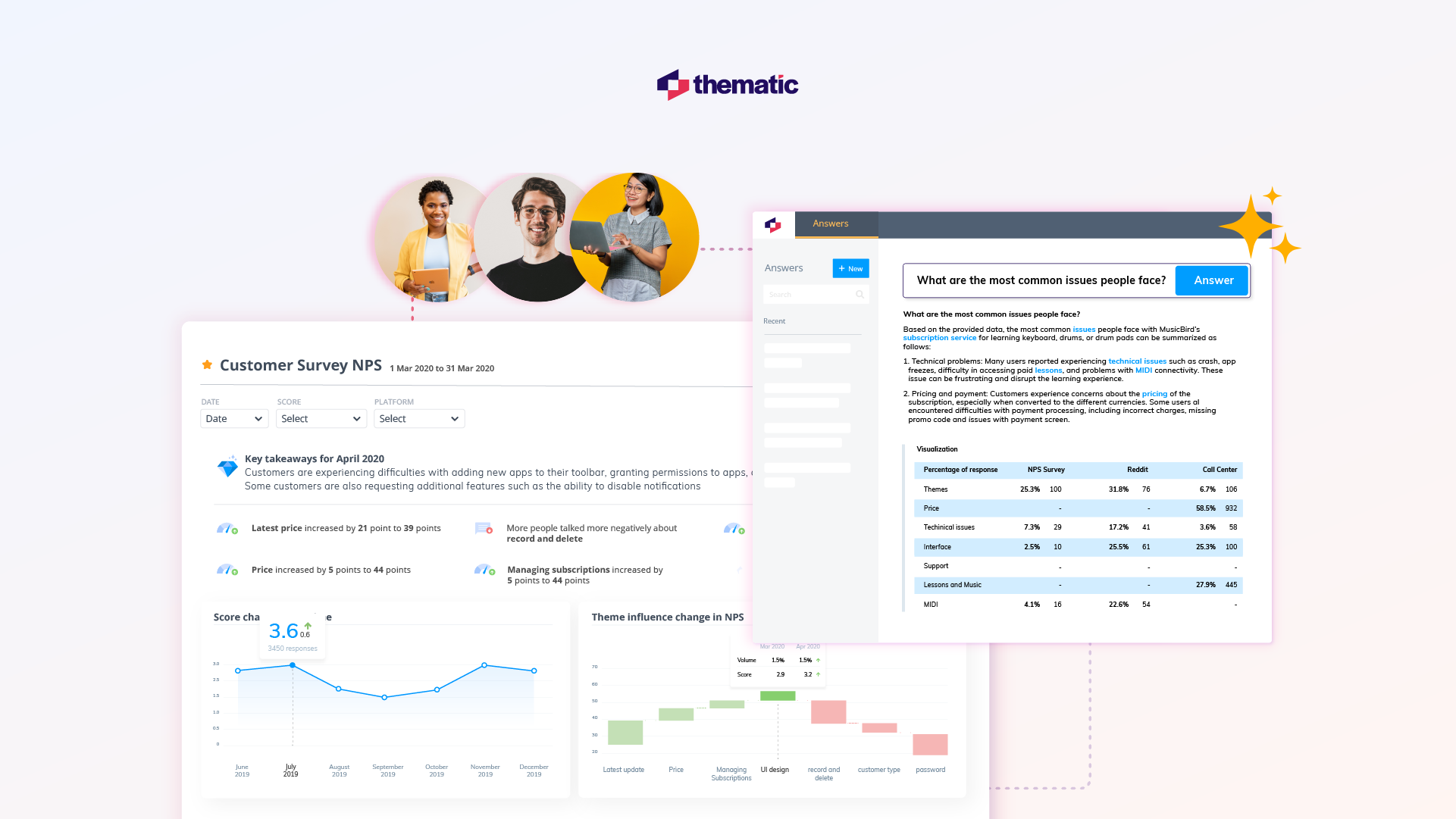
Measuring and Improving CX with Thematic
Thematic’s platform can analyze large volumes of unstructured data from direct and indirect sources, including social media, support centers, and CX channels like open-ended survey responses, reviews, interviews, and NPS, and transform them into high-quality, actionable insights with accurate coding and analytics.
Thematic’s powerful AI with LLMs discovers and quantifies what matters most to your customers. The platform extracts recurring themes, performs sentiment analysis within a few hours, analyzes feedback consistently, and automatically alerts you to new themes. You spend less time training models or manually coding data and more time using the insights to improve all components of the customer experience.
Let's say, the significant changes feature in Thematic shows feedback for a new product feature suddenly rises. Dive into the comments for that product feature, investigate sentiment and score shifts, and alert the product team of any issues to fix. Your customers will trust that you listen and act on their feedback.

Thematic
AI-powered software to transform qualitative data into powerful insights that drive decision making.
Other popular CX analytics tools commonly used for feedback analysis:
- Social media analytics: UnitQ and Sprout Social specialize in analyzing conversations on your social platforms and messaging apps.
- Support center analytics: Tools like Enterpret, SentiSum, CallMiner, and Zendesk focus on analyzing customer support data and provide insights that improve the support center experience.
- Feedback collection tools: SurveyMonkey and InMoment can be used to gather relevant data from a wide range of channels.Customer feedback analytics: TextIQ, Relative Insight, and XM Discover analyze qualitative data in different ways to draw out insights into what your customers want and need.
Common Challenges in Customer Experience Analysis
Securing Cross-Organizational Support
If key stakeholders are not on the same page, problems can begin before you even start gathering data. Some teams or executives may not see the value of customer experience analysis. And this could make it really hard to get ongoing support and the resources you need.
How to Fix It: Communicate clearly what you aim to achieve with customer experience analysis and include as much evidence as possible. Think about each department’s goals and how CX insights might impact them. You might reference case studies featuring organizations like yours. Or suggest a small-scale trial before your organization commits to a full CX analytics program.
Poor Quality Data
Bad data can mean unusable insights. There might be inconsistencies and inaccuracies that compound over time. For example, duplicate feedback from the same customer can skew your results, as can spam and inconsistencies across your feedback channels.
How to Fix It: Keep on top of your datasets by performing regular checks and data cleaning. Most AI analytics tools automatically clean your data and remove things like spam. But you should still perform spot checks and remove any customer feedback that doesn’t add value, is incomplete, or simply wrong!
Insufficient Survey Response Rates
Not having enough data is another common problem. You may get fewer survey responses than you anticipated. This can make it hard to get accurate and reliable insights. It’s easy for the results to be skewed with smaller datasets.
How to Fix It: If you’re having this problem, think about it from the customer’s perspective. Consider how your customers interact with your brand. Take a look at your survey design and see how you can make it more enticing and customer-friendly. And don’t forget to consider what they get out of it. You could offer a small incentive such as a discount or free gift to boost customer engagement.
Data Privacy Concerns
Customers are more concerned about their data than ever before. According to the Pew Research Centre, 81% of Americans are concerned about how companies use their data. And 75% say they don’t understand what companies are doing with their data. If your customers don’t trust you with their data, they’ll probably avoid filling out surveys or giving you any additional information. Loyal customers deserve clarity.
How to Fix It: Be transparent about how you use and collect customer data. And make sure they can opt-out at any point. Consider sharing your CX analytics insights with customers so they understand you’re using their data to improve the customer experience. This can help boost brand loyalty and customer retention.
Human Bias
We all have some biases. This can be a problem when it comes to interpreting your results. Preconceived ideas or expectations can skew how you see things. For example, you might already know about a product fault that needs to be fixed. But if you are too focused on this, you might miss a more urgent issue that you didn’t know about.
How to Fix It: The data comes first, not the insights. Try not to draw any conclusions until your analysis is complete. Sometimes your data can reveal uncomfortable truths about teams or individuals. In this case it’s best to take a neutral stance and focus on finding solutions that move the whole organization forward together.
Implementing Change
Change can be tough, especially if it is imposed from the outside. Teams who are not directly involved in the analysis process might be resistant to doing things differently. They may question why change is necessary.
For example, customer service teams may wonder why they’re suddenly being asked to use a different script. As far as they’re aware, the old one was working fine!
How to Fix It: Lead with your data when sharing your insights. It’s easier to get buy-in if those implementing changes understand the “why”. Make your data easy for everyone to understand using simple visualizations and summaries. Below you can see an example from Thematic with a useful summary of the theme “store out of stock” and statistics you could use to build your case.
Get better ROI from your customer experience insights
Improving customer experience and developing deeper relationships with your customers is 100x easier when you know what they want and need.
That’s really the crux of customer experience analytics. It’s all about discovering insights that enable you to personalize different touchpoints along the customer journey in a way that exceeds expectations and solves customer or product issues before they escalate.
And with the right customer experience analytics tool, you can save time and reduce the manual work burden on CX and UX research and insights teams.
Uncover the insights that will transform your customer experience. See how Thematic works, or get a free guided trial on your data today.
Stay up to date with the latest
Join the newsletter to receive the latest updates in your inbox.



